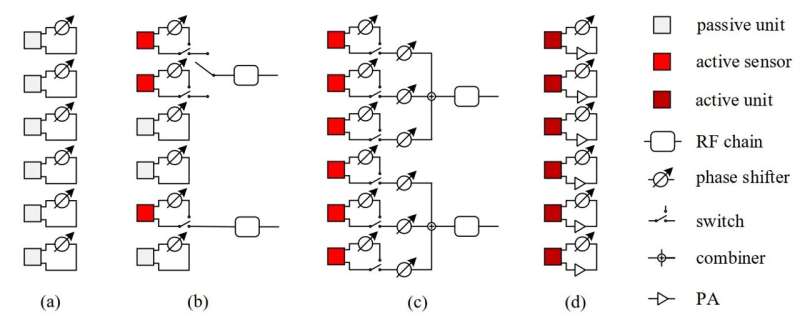This article has been reviewed according to Science X's editorial process and policies. Editors have highlighted the following attributes while ensuring the content's credibility:
fact-checked
trusted source
proofread
Acquiring CSI in RIS-assisted mobile communication systems

Mobile communication builds an invisible bridge between two users at geographically distant locations. To meet the growing communication demands of the users, widening the bridge is a direct and effective approach. By increasing antennas at transmitter and receiver sides, multiple parallel spatial channels can be formed, bringing to the multiplication of the bridge width. However, the continuous increase in the number of antennas inevitably leads to a surge in costs and power consumption.
To ensure effective utilization of the spatial resources, 6G introduces reconfigurable intelligent surfaces (RISs) into mobile communication systems. A RIS is composed of numerous subwavelength units, forming an extra large-scale array. By adjusting the electromagnetic response of each unit, flexible control over incident electromagnetic waves can be achieved. This, in turn, enables the widening of the invisible bridge in a cost-effective and energy-efficient manner.
It is worth mentioning that the invisible bridge in mobile communication systems, which is the wireless channel, is not constant but dynamically varies with the movement of the user device and the change of the surrounding environment. To optimize the transmission scheme, it is necessary to proactively detect this invisible bridge in real-time and design data transmission schemes that are more suitable for the bridge based on precise wireless channel state information (CSI) that is obtained by the system.
Initially, the RISs used in mobile communication systems only had signal reflection capabilities, and thus were unable to receive or process signals. This posed significant challenges in acquiring CSI in the transmitter-RIS-receiver link.
To overcome this obstacle, researchers and industry professionals have explored various approaches, such as enhancing the configuration of RISs and optimizing methods for CSI acquisition. As of now, a considerable amount of research achievements have been accumulated regarding how to acquire CSI in RIS-assisted mobile communication systems.
In a new article published in the National Science Review, the research team led by Professor Shi Jin from Southeast University and Professor Michail Matthaiou from Queen's University Belfast provided an overview of the acquisition of CSI in RIS-assisted mobile communication systems.
The article discusses the various categories of RISs currently used in mobile communication systems and analyzes the advantages and limitations of CSI acquisition for each category. It further categorizes CSI into implicit and explicit types and provides a comprehensive summary and comparison of CSI acquisition methods for these two types, considering factors such as applicable RIS categories, estimation objectives, estimation algorithms, and training overhead.
The article also discusses the challenges that need to be addressed in the future for CSI acquisition in RIS-assisted mobile communication systems, considering the new architecture and applications in 6G.
More information: Yu Han et al, CSI acquisition in RIS-assisted mobile communication systems, National Science Review (2023). DOI: 10.1093/nsr/nwad127





















